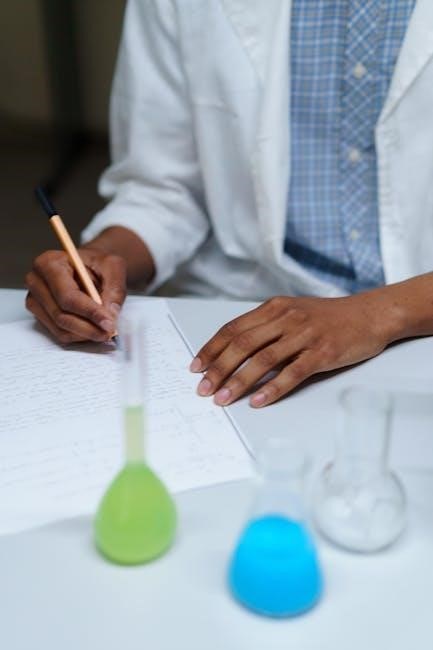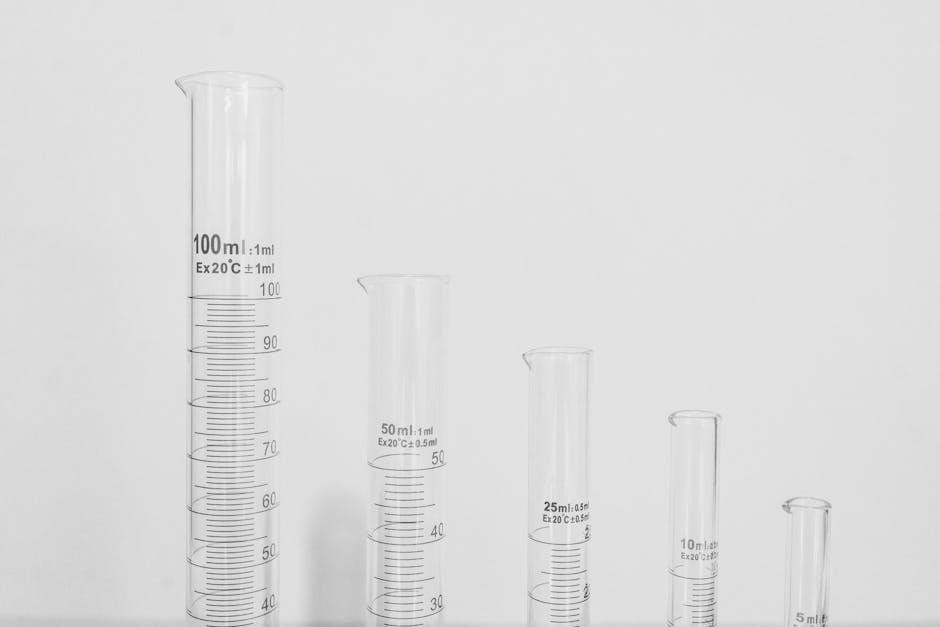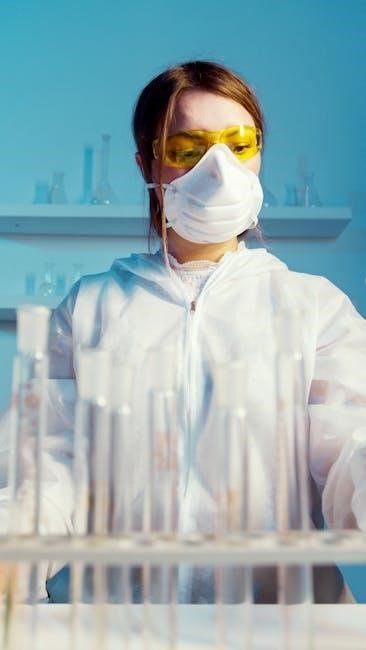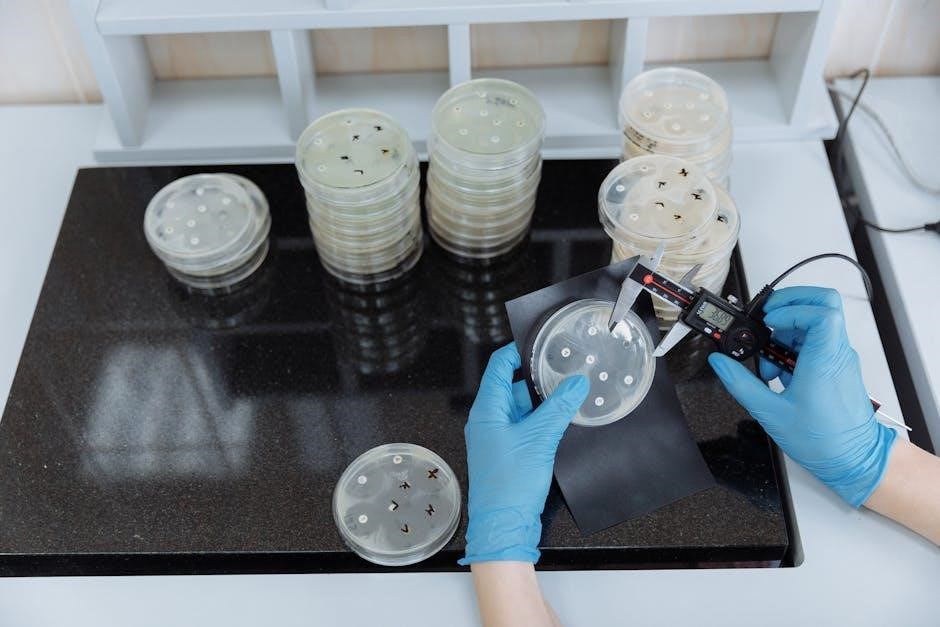Welcome to the introduction to lab glassware! This guide provides essential names and pictures of lab equipment, helping you identify and understand their functions in various laboratory settings.
1.1 Importance of Lab Glassware in Laboratory Work
Lab glassware is essential for conducting precise and safe experiments. Accurate measurements, contamination prevention, and experiment reproducibility rely on the correct tools. Knowing the names and functions of glassware ensures proper usage, minimizing errors. Resources like PDF guides provide visual aids, making identification easier. Understanding glassware is vital for maintaining lab safety and efficiency, as each piece serves a specific purpose in various procedures. This knowledge is foundational for scientists and students, enabling them to perform tasks confidently and accurately. Proper glassware handling also prevents damage and ensures long-term usability in laboratory settings.
1.2 Overview of Common Lab Glassware
Common lab glassware includes beakers, flasks, test tubes, funnels, and pipettes. Beakers are used for mixing and holding liquids, while flasks are ideal for storing or heating solutions. Test tubes are essential for chemical reactions and observations. Funnels assist in transferring liquids without spillage. Pipettes accurately measure and transfer small volumes of liquids. These tools are fundamental in laboratories for various procedures. Resources like PDF guides provide detailed pictures and names of glassware, helping users identify and understand their functions. Familiarity with this equipment is crucial for conducting experiments safely and effectively. These items are indispensable in both educational and professional lab settings.
1.3 Why Learning Lab Glassware Names and Pictures is Essential
Learning lab glassware names and pictures is crucial for effective laboratory work. Accurate identification ensures proper equipment selection, reducing errors in experiments. Familiarity with glassware enhances efficiency, as it streamlines workflows and minimizes confusion. Safety is also improved, as using the right tools prevents accidents. Additionally, understanding glassware names and functions fosters professionalism and confidence in lab settings. Resources like PDF guides provide clear visuals and descriptions, making learning accessible. Mastery of this knowledge is foundational for students and professionals alike, ensuring precise and reliable outcomes in scientific procedures. It also aids in communication among team members, promoting collaboration and consistency in lab activities.
Essential Lab Glassware

Discover the names and pictures of fundamental lab tools like beakers, flasks, test tubes, and funnels. These items are indispensable for everyday laboratory tasks and experiments, ensuring accuracy and efficiency.
2.1 Beakers
Beakers are essential lab glassware used for mixing, heating, and storing liquids. They are cylindrical with a flat bottom and open top, available in various sizes. Made from borosilicate glass, they resist thermal shock. Common sizes range from 50ml to 2000ml. Beakers are durable and versatile, ideal for everyday lab tasks. Their wide mouths allow easy pouring and stirring. They are a must-have for any laboratory setup, providing reliable service in chemical reactions and experiments. Identifying beakers is straightforward due to their distinct shape and size. Refer to lab glassware PDF guides for clear pictures and detailed descriptions to enhance your recognition skills.
2.2 Erlenmeyer Flasks

Erlenmeyer flasks are conical-shaped lab glassware with a narrow neck and wide base, ideal for mixing and heating liquids. They are made from borosilicate glass, resistant to thermal shock. Commonly used in titrations and chemical reactions, these flasks are available in sizes ranging from 50ml to 2000ml. Their design prevents liquids from splashing, making them safe for heating. Erlenmeyer flasks are a staple in chemistry labs due to their versatility and durability. For easy identification, refer to lab glassware PDF guides, which provide clear images and descriptions. Recognizing these flasks is essential for laboratory work, as they are frequently used in various experiments and procedures.
2.3 Test Tubes
Test tubes are cylindrical glassware used to hold small quantities of substances for experiments. They are typically 10-20 cm long with open ends and rounded bottoms. Made from borosilicate glass, they resist thermal shock, making them suitable for heating. Test tubes are essential for chemical reactions, mixing, and observing substances. Available in various sizes, they often have markings for volume measurement. Some have rims to prevent splashing during heating. For easy identification, refer to lab glassware PDF guides, which include images and descriptions. Recognizing test tubes is crucial for laboratory safety and efficiency, as they are widely used in chemistry and biology labs.
2.4 Funnels
Funnels are cone-shaped laboratory tools used to guide liquids or powders into containers with narrow openings. They are typically made of glass or plastic and come in various sizes. Funnels are essential for transferring substances without spilling, especially during titrations or when handling volatile chemicals. Some funnels, like separatory funnels, have stopcocks for controlled flow. Others, such as powder funnels, are designed for solids. Learning to identify funnels from lab glassware pictures and PDF guides is crucial for safe and efficient lab work. Proper use of funnels prevents accidents and ensures accurate measurements in experiments.

Specialized Lab Glassware
Specialized lab glassware includes volumetric flasks, burettes, pipettes, and wash bottles. These tools are crucial for precise measurements and essential for various laboratory tasks. Refer to lab glassware names and pictures PDF guides for easy identification and understanding of their functions.
3.1 Volumetric Flasks

Volumetric flasks are specialized glassware used for precise measurements of liquid volumes. They have a single graduation mark, indicating their capacity, and are essential for preparing solutions. Available in various sizes, they ensure accuracy in titration and laboratory experiments. Refer to lab glassware names and pictures PDF guides for detailed images and descriptions to identify and understand their proper use in laboratory settings. These resources are invaluable for students and professionals alike, providing clear visuals and functional insights.
3.2 Burettes
Burettes are cylindrical glassware with a graduated scale, used to measure and transfer precise volumes of liquids. They are essential for titration procedures, allowing accurate delivery of reagents. Featuring a stopcock at the bottom, burettes enable controlled release of liquids, making them indispensable in quantitative analysis. Their design ensures minimal error in measurements, crucial for precise laboratory results. Refer to lab glassware names and pictures PDF guides for clear images and descriptions to better understand their structure and operation. These resources are ideal for students and professionals seeking to master laboratory techniques and equipment identification.
3.3 Pipettes
Pipettes are laboratory tools used to measure and transfer precise volumes of liquids. They are available in various designs, including volumetric and transfer pipettes, each tailored for specific tasks. Pipettes are essential for accurate measurements, particularly in titrations and dilutions. They often feature adjustable volume settings and are made from glass or plastic. Their precision makes them indispensable in biochemical and chemical laboratories. Learning to identify pipettes from lab glassware names and pictures PDF guides helps in understanding their functions and proper usage. Regular practice with pipettes enhances laboratory skills and ensures reliable experimental results. They are a cornerstone of precise liquid handling in scientific settings.
3.4 Wash Bottles
Wash bottles are essential laboratory tools used for rinsing and cleaning glassware. They typically feature a squeeze-bottle design with a narrow nozzle, allowing precise control over the liquid dispensed. Wash bottles are commonly filled with distilled water or solvents, depending on the cleaning requirements. They are crucial for maintaining cleanliness in the lab, ensuring that equipment is free from contaminants. Learning to identify wash bottles from lab glassware names and pictures PDF guides helps in understanding their role in laboratory hygiene. Proper use of wash bottles prevents cross-contamination and ensures accurate experimental results. They are a simple yet vital component in every laboratory setup.

Measurement and Transfer Tools
These tools, like graduated cylinders and pipettes, are crucial for precise liquid measurement and transfer. Lab glassware names and pictures PDF guides help identify and use them effectively.
4.1 Graduated Cylinders
Graduated cylinders are essential tools for accurately measuring liquid volumes in laboratories. They feature a calibrated scale on the side, allowing precise measurements. Available in various sizes, they are typically made of glass or plastic. These cylinders are widely used in titrations, dilutions, and mixing solutions. Lab glassware names and pictures PDF guides often include detailed images and descriptions of graduated cylinders, helping users identify and understand their proper use. Learning to read the graduations correctly is a fundamental skill in laboratory work. PDF resources provide clear visuals and instructions, making it easier for students and professionals to master the use of graduated cylinders effectively.
4.2 Measuring Pipettes
Measuring pipettes are precision instruments used to transfer and measure specific volumes of liquids accurately. They are commonly used in laboratories for titrations, dilutions, and sample preparations. Available in various sizes, pipettes are designed to deliver precise measurements, ensuring accuracy in experiments. Lab glassware names and pictures PDF guides often include detailed images and descriptions of different pipette types, such as volumetric and transfer pipettes. These resources help users identify and understand the proper use of each pipette, enhancing their laboratory skills. Learning to use measuring pipettes correctly is a critical skill for achieving reliable results in scientific experiments and analyses.
4.3 Burets
Burets are essential laboratory tools designed to deliver accurate volumes of liquids, particularly in titration procedures. They consist of a graduated tube with a stopcock at the bottom, allowing precise control over liquid flow. Burets are calibrated to measure specific volumes, making them indispensable for quantitative analysis. Unlike pipettes, burets are typically used for larger volumes and offer high precision in measurements. Lab glassware names and pictures PDF guides often feature detailed images of burets, highlighting their structure and function. These resources help users identify and understand the proper use of burets, ensuring accurate and reliable results in laboratory experiments and analyses.
4.4 Transfer Pipettes
Transfer pipettes are laboratory tools used to move liquids from one container to another without measuring specific volumes. They are typically made of plastic or glass and come in various designs, such as bulb pipettes or piston pipettes. Unlike measuring pipettes, transfer pipettes are not calibrated for precise measurements but are ideal for general liquid handling. Lab glassware names and pictures PDF guides often include images of transfer pipettes, showcasing their simple design and functionality. These resources help users identify and understand the appropriate use of transfer pipettes in laboratory settings, ensuring efficient and safe liquid transfers during experiments.

Lab Glassware Identification
Identify lab glassware by shape, function, and pictures in PDF guides. These resources help recognize equipment like beakers, flasks, and pipettes, ensuring accurate use in experiments.
5.1 Identifying Glassware by Shape
Identifying lab glassware by shape is a practical skill for laboratory work. Beakers, with their straight sides, are used for mixing, while Erlenmeyer flasks, featuring a narrow neck, are ideal for heating. Test tubes, cylindrical and open-ended, hold samples for experiments. Funnels, with their wide mouths and tapered ends, facilitate pouring liquids. Shapes often reflect specific functions, making recognition easier. For instance, volumetric flasks have a single graduation mark for precise measurements, while burettes are tall and narrow for titration. Using PDF guides with pictures helps students match shapes to names, ensuring accurate identification and proper use in experiments. This skill is crucial for safety and efficiency in lab settings.
5.2 Identifying Glassware by Function
Identifying lab glassware by function is essential for effective laboratory work. Beakers are used for mixing and storing liquids, while Erlenmeyer flasks are designed for heating substances. Test tubes hold samples for experiments, and funnels assist in pouring liquids into containers. Volumetric flasks measure precise volumes, and burettes deliver accurate amounts during titration. Pipettes transfer small, measured quantities of liquids. Understanding the purpose of each tool helps in selecting the right glassware for specific tasks. By studying names and pictures in PDF guides, students can match functions to shapes, ensuring correct usage and enhancing laboratory efficiency and safety. This method streamlines workflows and reduces errors in experiments.
5.3 Using Pictures for Easy Recognition
Using pictures is an effective way to recognize lab glassware quickly. Visual guides, often available in PDF format, provide clear images of equipment like beakers, flasks, and pipettes. By associating names with visuals, students can easily identify tools in a laboratory setting. This method enhances memory retention and reduces confusion. Many online resources offer downloadable PDF charts with labeled images, making it easier to study and reference. Pictures also help in distinguishing similar-looking glassware, such as burettes and pipettes. This visual approach simplifies learning and ensures accurate identification, making it a valuable tool for both students and professionals in scientific fields. Regular use of these resources improves familiarity and confidence in lab settings.
Lab Glassware in PDF Format
Downloadable PDF guides provide comprehensive lists of lab glassware, including names and high-quality images. These resources are perfect for students and professionals, offering easy reference and study.
6.1 Benefits of Using PDF Guides
PDF guides are an excellent resource for learning lab glassware, offering clear names and pictures of equipment. They provide comprehensive information on functions and uses, making them ideal for quick reference. These guides are easily accessible, printable, and can be used offline, ensuring convenience for students and professionals. Many PDFs are organized alphabetically or by category, simplifying the learning process. They often include high-quality images, enabling easy identification of glassware. Additionally, PDF guides are shareable and can be annotated, making them a valuable tool for study and lab preparation. Their portability and ease of use make them indispensable for mastering lab glassware effectively.
6.2 Downloading Lab Glassware PDFs
Downloading lab glassware PDFs is a straightforward process, with many resources available online. Websites offer free guides containing names and pictures of equipment, ideal for students and professionals. These PDFs are often comprehensive, featuring high-quality images and detailed descriptions. To find reliable sources, search for “lab glassware names and pictures PDF” or visit educational websites. Some guides are designed as cheat sheets, focusing on essential items like beakers, flasks, and pipettes. Ensure the PDF is from a credible source for accuracy. Once downloaded, these guides can be printed or saved digitally, making them a convenient tool for learning and reference.
6.3 Popular Lab Glassware PDF Resources
Several popular PDF resources provide detailed guides to lab glassware, including names and pictures. Websites like Honors Chemistry 412 Lab offer comprehensive guides with images and functions of 29 common pieces of equipment. Another widely used resource is the guide from TheLab.gr, which includes high-quality images and descriptions. Additionally, a free downloadable PDF from various educational sites lists essential lab items, such as beakers, flasks, and pipettes, with clear visuals. These resources are perfect for students and professionals, offering easy reference for identification and use. They are often free to download and can be printed or saved digitally for convenience.
Lab Setup and Safety
Properly setting up your workstation and following safety protocols are crucial. Always handle glassware with care, use gloves, and ensure safe storage to prevent breakage and contamination.
7.1 Setting Up a Laboratory Workstation
Setting up a laboratory workstation requires organization and efficiency. Start by arranging essential lab glassware such as beakers, flasks, and pipettes within easy reach. Use a clean, stable surface and ensure proper lighting. Refer to PDF guides for quick identification of equipment. Place frequently used items like test tubes and funnels in accessible locations. Keep hazardous materials separate and label all containers clearly. Wear protective gear, including gloves and goggles, to maintain safety. Finally, organize your workspace to minimize clutter and avoid accidents. A well-organized workstation enhances productivity and ensures safe laboratory practices.
7.2 Safety Precautions with Lab Glassware

Handling lab glassware requires careful attention to safety. Always wear protective gear, including gloves, goggles, and a lab coat, to prevent injuries. Inspect glassware for cracks or damage before use, as broken items can cause cuts or contamination. Avoid using bare hands to handle hot or cold glassware; use tongs or heat-resistant gloves instead. Never force glassware to fit into tight spaces, as this can lead to breakage. Store glassware properly in designated areas to prevent accidental damage. Dispose of broken glassware safely, using a sealed container to avoid sharp edges. Refer to PDF guides for proper handling techniques to ensure a safe laboratory environment.
7.3 Proper Handling and Storage
Proper handling and storage of lab glassware are crucial to maintain its integrity and longevity. Always handle glassware with clean, dry hands or use tongs to prevent contamination and breakage. Avoid exposing glassware to extreme temperatures or sudden changes, as this can cause cracking. Store glassware in designated, padded containers or racks to prevent chipping and breakage. Ensure all items are clean and dry before storage to avoid residue buildup. Never stack delicate glassware, such as test tubes or pipettes, as this can lead to damage. Refer to PDF guides for detailed storage recommendations and handling techniques to preserve your lab equipment effectively.

Learning Resources
Access PDF guides, online tutorials, and printable charts to master lab glassware. Interactive tools and detailed posters provide visual aids for easy recognition and understanding of equipment names and functions.
8.1 Online Guides for Lab Glassware
Online guides are invaluable for learning lab glassware names and functions. Websites like Honors Chemistry 412 Lab 1 offer detailed pictures and descriptions of 29 essential pieces of equipment. These resources provide interactive tools, such as clickable images and quizzes, to test your knowledge. Many guides are available in PDF format, making them easy to download and study offline. They often include high-quality images, diagrams, and charts to help users identify glassware by shape and function. Whether you’re a student, teacher, or professional, these guides are a comprehensive resource for mastering lab equipment. They are accessible anytime, ensuring convenient learning and reference.
8.2 Printable Charts and Posters
Printable charts and posters are excellent tools for learning lab glassware names and pictures. These visual aids provide a quick reference for identifying equipment, making them ideal for classroom or lab use. Many resources, such as the Lab Glassware Names and Pictures PDF, offer high-quality images and diagrams that can be printed in poster format. They often include labels and descriptions, helping users match names with visuals. Websites like TheLab.gr and educational platforms provide free downloadable charts, ensuring easy access. These posters are particularly useful for students and educators, as they simplify the learning process and serve as a handy study guide for lab preparation.
8.3 Interactive Learning Tools
Interactive learning tools offer a dynamic way to master lab glassware names and pictures. Online platforms provide quizzes, flashcards, and matching games that test your knowledge. Some tools feature 3D models of glassware, allowing you to explore their shapes and functions in detail. Virtual lab simulations let you practice using equipment in a risk-free environment. These tools are especially helpful for visual and hands-on learners. Many websites, like those mentioned in the Lab Glassware Names and Pictures PDF, offer free access to these resources. Interactive tools make learning engaging and effective, helping you retain information better than static charts or posters alone.

Conclusion
Mastering lab glassware names and understanding their uses is essential for laboratory success. Utilize PDF guides and interactive tools to enhance your learning journey and stay confident in lab settings.
9.1 Summary of Key Lab Glassware
In summary, essential lab glassware includes beakers, Erlenmeyer flasks, test tubes, and pipettes, each serving unique purposes in measurements and experiments. Specialized tools like burettes and volumetric flasks are crucial for precise measurements, while funnels and transfer pipettes aid in liquid handling. Identifying glassware by shape or function is simplified with resources like PDF guides, which provide clear names and pictures. These resources are invaluable for students and professionals, ensuring accurate identification and proper usage. By mastering this knowledge, one can efficiently navigate laboratory tasks with confidence and precision.
9.2 Encouragement to Use PDF Resources
Using PDF resources is an excellent way to master lab glassware identification and usage. These guides offer comprehensive collections of names and pictures, making learning easier and more efficient. Many PDFs are free to download and provide clear, labeled images of equipment like beakers, flasks, and pipettes. They are ideal for students and professionals alike, serving as quick references for both study and practical work. By utilizing these resources, you can enhance your understanding of lab tools and their functions, ensuring accuracy and confidence in laboratory settings. Embrace PDF guides as a valuable tool for mastering lab glassware effectively.
9.3 Final Tips for Mastering Lab Glassware
To master lab glassware, start by regularly practicing with PDF guides that include names and pictures. Use flashcards to memorize equipment names and their functions. Focus on understanding shapes and purposes, as this aids in quick identification. Test yourself by labeling unlabeled images or describing uses without reference. Hands-on practice in a lab setting reinforces learning. Additionally, utilize online quizzes and interactive tools to assess your knowledge. Consistency is key—spend a few minutes daily reviewing. Finally, teach others what you’ve learned, as explaining concepts strengthens your own understanding. With dedication and these strategies, you’ll become proficient in identifying and using lab glassware confidently.
